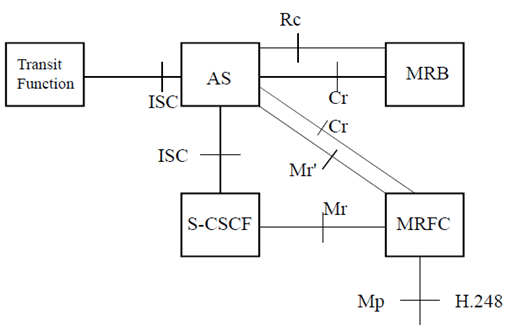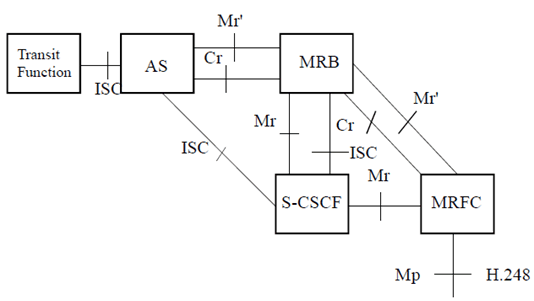Content for TS 23.218 Word version: 18.0.0
10 IP multimedia session handling with IM-SSF Application Server
11 IP multimedia session handling with an OSA-Service Capability Server
12 IP multimedia session handling with an Charging Server
13 Media resource broker (MRB)
13.0 General
13.1 MRB Query Mode
13.2 MRB In-Line Mode
13.3 MRB knowledge of MRF resources and other information
...
...
10 IP multimedia session handling with IM-SSF Application Server p. 45
This subclause describes the functional architecture needed to support CAMEL interactions with the S-CSCF and the Transit Function in the IP Multimedia Subsystem. The IM-SSF is a SIP Application Server that interfaces SIP to CAP. The generic SIP Application Server behaviour of the IM-SSF is specified in clause 9 of the present document.
The detailed CAMEL procedures for IM-SSF Application Server are specified in TS 23.278.
11 IP multimedia session handling with an OSA-Service Capability Server p. 45
This subclause describes the functional architecture needed to support interactions with the S-CSCF and the Transit Function in the IP Multimedia Subsystem and the OSA-SCS. The OSA-Service Capability Server is a SIP Application Server which interfaces SIP to the OSA framework. The generic SIP Application Server behaviour of the OSC-SCS is specified in clause 9 of the present document.
The detailed OSA-SCS procedures for IMS Application Server are specified in TR 29.998.
12 IP multimedia session handling with an Charging Server p. 45
This clause describes the functional architecture needed to support interactions with the S-CSCF in the IP Multimedia Subsystem and Charging Server. The Charging Server is a specific SIP Application Server that performs the role of online charging mechanism for the Event Charging Function (ECF) and Session Charging Function (SCF).
The detailed procedures for Charging Server are specified in TS 32.240 and TS 32.260.
13 Media resource broker (MRB) |R8| p. 46
13.0 General |R11| p. 46
The Media Resource Broker (MRB) is a functional entity that is responsible for both collection of appropriate published MRF information and supplying of appropriate MRF information to consuming entities such as the AS. Therefore, the MRB is responsible for supporting the identification and selection of appropriate MRF resources.
The MRB supports the sharing of a pool of heterogeneous MRF resources by multiple heterogeneous applications. MRB assigns (and later releases) specific suitable MRF resources to calls as requested by the consuming applications, based on MRF attributes specified by the applications as well as other criteria.
The MRB may take the following kinds of information into account when assigning MRF resources to an application:
- the specific characteristics of the media resources required for the call or calls;
- the identity of the application;
- rules for allocating MRF resources across different applications;
- per-application or per-subscriber SLA or QoS criteria;
- capacity models of particular MRF resources; and
- if it can use the services of another (visited network) MRB.
- the role of MRB is the same - assignment of MRF resources to calls as requested by applications;
- an application server provides the same kind of information to MRB on MRF attributes needed for a given call; and
- the way MRB acquires knowledge of MRF resources and other information needed to perform its role is the same (see subclause 13.3).
- be the entity that determines when an MRF resource can be released;
- request and be assigned MRF resources for multiple calls in advance; and do that in a single request/response; and
- incrementally request more MRF resources or release resources that it determines aren't in fact needed.
13.1 MRB Query Mode p. 47

With Query mode, the AS queries the MRB with a request for media resources with certain attributes using the Rc interface. The MRB selects suitable MRF Resources, assigns them to that AS/application, and responds to the AS with the addresses of the selected MRF resources.
Once the AS receives the response from MRB, it sets up the call or calls to the MRFC either through the S-CSCF (ISC and Mr interface) or directly to the MRFC (Mr' interface), using the MRF address information supplied by MRB. Control packages are supported over the Cr interface.
When the AS/application is done using a MRF resource, it sends another message to MRB indicating so, and MRB returns that resource to the idle pool and acknowledges to the AS/application.
13.2 MRB In-Line Mode p. 48

With In-Line mode, the MRB is between the AS and the MRFC. The AS sends a request to establish a dialog to the MRB (using the Mr' interface, or via the S-CSCF using the ISC and Mr interface). The request can contain information relating to the kind of MRF required to handle that particular call. The MRB selects an appropriate MRF resource and sends the request along to the MRF (using the Mr' interface, or via the S-CSCF using the ISC and Mr interface). Subsequent messages in the same dialog between the AS and MRFC traverse the MRB (as well as the S-CSCF if that was in the path between the AS and the MRB, or between the MRB and the MRFC).
Control packages are supported over the Cr interface directly between AS and MRFC.
The MRB infers that the media resource is no longer needed when it sees a session release request from either the AS or MRFC.
13.3 MRB knowledge of MRF resources and other information p. 48
In order to perform its function, MRB may need the following kinds of information (this is not necessarily an exhaustive list):
- available MRF resources and their attributes; current and future. This may take into account planned and unplanned downtime and the scheduled addition/deletion or availability of MRF resources;
- rules for fair-share allocation across applications;
- capacity models for particular MRF resources; and
- reservations for future use of media resources (for example, for conferencing, or for anticipated traffic spikes for other applications such as a FreePhone application).